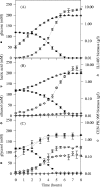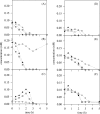Transcriptome analysis of Lactococcus lactis in coculture with Saccharomyces cerevisiae
- PMID: 17993564
- PMCID: PMC2223240
- DOI: 10.1128/AEM.01531-07
Transcriptome analysis of Lactococcus lactis in coculture with Saccharomyces cerevisiae
Abstract
The study of microbial interactions in mixed cultures remains an important conceptual and methodological challenge for which transcriptome analysis could prove to be the essential method for improving our understanding. However, the use of whole-genome DNA chips is often restricted to the pure culture of the species for which the chips were designed. In this study, massive cross-hybridization was observed between the foreign cDNA and the specific Lactococcus lactis DNA chip. A very simple method is proposed to considerably decrease this nonspecific hybridization, consisting of adding the microbial partner's DNA. A correlation was established between the resulting cross-hybridization and the phylogenetic distance between the microbial partners. The response of L. lactis to the presence of Saccharomyces cerevisiae was analyzed during the exponential growth phase in fermentors under defined growth conditions. Although no differences between growth kinetics were observed for the pure and the mixed cultures of L. lactis, the mRNA levels of 158 genes were significantly modified. More particularly, a strong reorientation of pyrimidine metabolism was observed when L. lactis was grown in mixed cultures. These changes in transcript abundance were demonstrated to be regulated by the ethanol produced by the yeast and were confirmed by an independent method (quantitative reverse transcription-PCR).
Figures





Similar articles
-
Exploring suppression subtractive hybridization (SSH) for discriminating Lactococcus lactis ssp. cremoris SK11 and ATCC 19257 in mixed culture based on the expression of strain-specific genes.J Appl Microbiol. 2011 Feb;110(2):499-512. doi: 10.1111/j.1365-2672.2010.04902.x. Epub 2010 Dec 8. J Appl Microbiol. 2011. PMID: 21143356
-
Application of reverse transcriptase PCR-based T-RFLP to perform semi-quantitative analysis of metabolically active bacteria in dairy fermentations.J Microbiol Methods. 2006 May;65(2):268-77. doi: 10.1016/j.mimet.2005.07.018. Epub 2005 Sep 21. J Microbiol Methods. 2006. PMID: 16181692
-
A one step genotypic identification of Lactococcus lactis subspecies at the species/strain levels.Syst Appl Microbiol. 2011 Sep;34(6):429-34. doi: 10.1016/j.syapm.2011.01.011. Epub 2011 May 31. Syst Appl Microbiol. 2011. PMID: 21621939
-
Transcriptional responses in Lactococcus lactis subsp. cremoris to the changes in oxygen and redox potential during milk acidification.Lett Appl Microbiol. 2016 Aug;63(2):117-23. doi: 10.1111/lam.12596. Lett Appl Microbiol. 2016. PMID: 27234372
-
The Evolution of gene regulation research in Lactococcus lactis.FEMS Microbiol Rev. 2017 Aug 1;41(Supp_1):S220-S243. doi: 10.1093/femsre/fux028. FEMS Microbiol Rev. 2017. PMID: 28830093 Review.
Cited by
-
Synergistic Regulation of Transcription and Translation in Escherichia coli Revealed by Codirectional Increases in mRNA Concentration and Translation Efficiency.Microbiol Spectr. 2022 Feb 23;10(1):e0204121. doi: 10.1128/spectrum.02041-21. Epub 2022 Feb 9. Microbiol Spectr. 2022. PMID: 35138139 Free PMC article.
-
The forgotten role of food cultures.FEMS Microbiol Lett. 2021 Jul 15;368(14):fnab085. doi: 10.1093/femsle/fnab085. FEMS Microbiol Lett. 2021. PMID: 34223876 Free PMC article. Review.
-
Transcriptome of the quorum-sensing signal-degrading Rhodococcus erythropolis responds differentially to virulent and avirulent Pectobacterium atrosepticum.Heredity (Edinb). 2015 May;114(5):476-84. doi: 10.1038/hdy.2014.121. Epub 2015 Jan 14. Heredity (Edinb). 2015. PMID: 25585922 Free PMC article.
-
Transcriptomic Responses of the Interactions between Clostridium cellulovorans 743B and Rhodopseudomonas palustris CGA009 in a Cellulose-Grown Coculture for Enhanced Hydrogen Production.Appl Environ Microbiol. 2016 Jul 15;82(15):4546-4559. doi: 10.1128/AEM.00789-16. Print 2016 Aug 1. Appl Environ Microbiol. 2016. PMID: 27208134 Free PMC article.
-
Proteomics and transcriptomics characterization of bile stress response in probiotic Lactobacillus rhamnosus GG.Mol Cell Proteomics. 2011 Feb;10(2):M110.002741. doi: 10.1074/mcp.M110.002741. Epub 2010 Nov 15. Mol Cell Proteomics. 2011. PMID: 21078892 Free PMC article.
References
-
- Arsene-Ploetze, F., V. Kugler, J. Martinussen, and F. Bringel. 2006. Expression of the pyr operon of Lactobacillus plantarum is regulated by inorganic carbon availability through a second regulator, PyrR2, homologous to the pyrimidine-dependent regulator PyrR1. J. Bacteriol. 188:8607-8616. - PMC - PubMed
-
- Barrière, C., M. Veiga-da-Cunha, N. Pons, E. Guédon, S. A. van Hijum, J. Kok, O. P. Kuipers, D. S. Ehrlich, and P. Renault. 2005. Fructose utilization in Lactococcus lactis as a model for low-GC gram-positive bacteria: its regulator, signal, and DNA-binding site. J. Bacteriol. 187:3752-3761. - PMC - PubMed
Publication types
MeSH terms
Substances
LinkOut - more resources
Full Text Sources
Molecular Biology Databases

